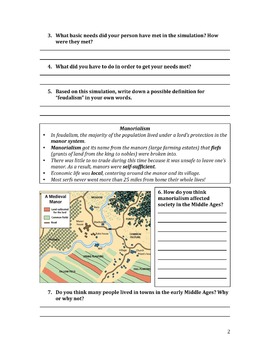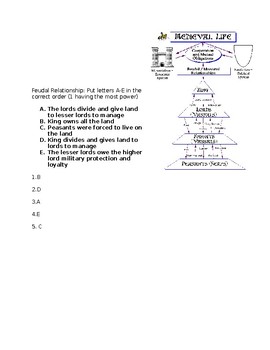
Interesting Facts about the Feudal System They worked long days, 6 days a week, and often barely had enough food to survive. They owned nothing and were pledged to their local lord.
#Feudalism in the middle ages worksheet free#
Some peasants were considered free and could own their own businesses like carpenters, bakers, and blacksmiths. Most of the people living in the Middle Ages were peasants. The lords owned everything on their land including the peasants, crops, and village. They also were the king's knights and could be called into battle at any moment by their Baron. Lords and Knights - The lords ran the local manors. If they did not have an army, sometimes they would pay the king a tax instead. Their job was to maintain an army that was at the king's service. They divided up their land among Lords who ran individual manors. They reported directly to the king and were very powerful. This made some Bishops very rich.īarons and Nobles- The Barons and high ranking nobles ruled large areas of land called fiefs. Not only that, but the church received a tithe of 10 percent from all the people. The Catholic Church was very powerful in most parts of Medieval Europe and this made the Bishop powerful as well.

When one family stayed in power for a long time, this was called a dynasty.īishop - The Bishop was the top church leader in the kingdom and managed an area called a diocese. When a king died, his firstborn son would inherit the throne. In return, the Barons pledged their loyalty and soldiers to the king.

The king could not control all of the land by himself, so he divided it up among the Barons. King - The top leader in the land was the king. Farms would then spread out from there which would be worked by the peasants. A small village would form around the castle which would include the local church. He lived in a large house or castle where people would gather for celebrations or for protection if they were attacked. The center of life in the Middle Ages was the manor. It started at the top with the king granting his land to a baron for soldiers all the way down to a peasant getting land to grow crops.

Donn has an excellent website that includes a section on the Middle Ages.Under the feudal system land was granted to people for service. View a Powerpoint presentation on Feudalism. These changes in society would lead to the Renaissance-the rebirth of Europe and the beginning of modern history.ĭownload this lesson as Microsoft Word file or as an Adobe Acrobat file. The introduction of gunpowder and long-range cannons made knights fighting with swords on horseback an outdated form of warfare that was expensive to train and support.Īt about the same time, cities were growing in population for the first time since the fall of the Roman Empire. A terrible disease called the Black Death claimed the lives of millions of Europeans in the fourteenth century, so in many places there were not enough peasants to farm the vast estates. The feudal system proved impractical by the end of the Middle Ages. For centuries, a person’s life was all but guaranteed to be exactly like their parents’ lives. A serf who lived on the manor of a Lord was likely the descendant of a peasant who had served the ancestor of that Lord. Lords often forced families to pay a tax when a member of their household died to compensate for the manor’s loss of labor.Īdvertisement There was very little social mobility, or chance to move upward in status during the Middle Ages. Serfs were encouraged to have many children because a small family might not have enough daylight hours to tend their family plot after their work in the Lord’s fields was complete. Serfs were not allowed to marry without permission from the Lord the family of a serf would have to turn over additional crops when someone wanted to marry and leave the manor. In exchange, serfs were required to work a particular number of days on the lord’s personal fields. The Lord provided the serf and his family a safe place to live and land to grow food. Serfs could not be sold as slaves, but they could not leave their manor without permission from the Lord.


 0 kommentar(er)
0 kommentar(er)
